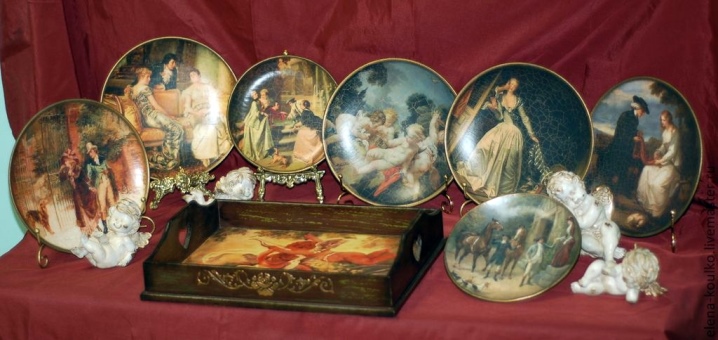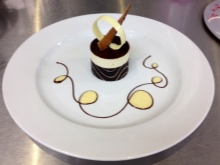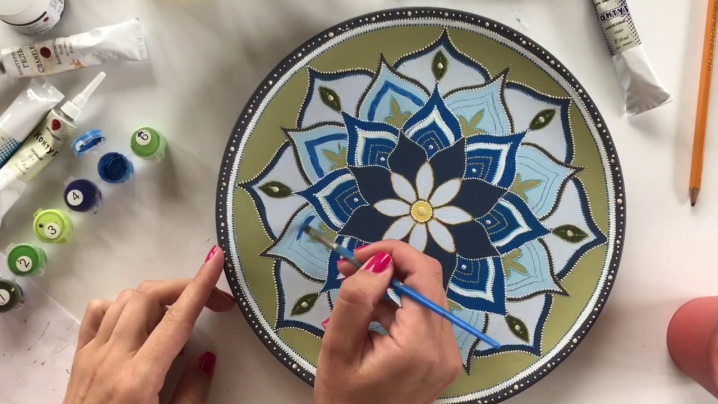How to decorate a plate with your own hands?

Decorative plates in the interior are not an innovation, not the latest squeak of fashion, but an already established, classic wall decoration. If you correctly arrange the composition of the plates on the wall, you will get a beautiful and unconventional panel from the same type, but still different elements. It is always interesting to become involved in creativity, to do something yourself, and even more so to independently deal with the decor of your home. And sometimes the first step to this is decorating the plate with your own hands.

Decorating options
You can decorate the dishes in different ways. The first (and also the most popular option) is painting. Gzhel and Khokhloma in the Russian style, stained-glass window, and maybe stylization of a fairy tale, imitation of watercolor sketches - there is something from which to choose. In addition to painting, decorative plates can be transformed with:
- decoupage,

- marmorization,

- point technology,

- lettering and much more.



It only seems that simply decorating or painting is the simplest solution. We need special paints, fixatives, templates, and finally, elementary artistic skills. And if a person last held a brush in his hands at school, then you can use a different technique, for example, make decoupage on a plate.
Decoupage
Decoupage is, to put it another way, an application. You need to take some illustrations, pictures, then in the thinnest form you need to fix them on the base, cover them with clamps. One gets the impression that the drawing is not glued, but as if it was originally on the plate. In every sense, this is a delicate job. What you need:
- the plate itself,
- drawing (postcard, napkin or picture printed from the Internet);
- deep bowl;
- scissors;
- glue;
- paint brush;
- acrylic lacquer;
- a tin can with a ring for opening (for example, from corn).

You need to act in stages. A special acrylic varnish should be delicately applied to the image with a brush. The varnish is applied in at least five layers. Each new layer covers the previous one only when it dries. Once the image is varnished, it should be immersed in a dry bowl for 15 minutes with water. Then the image is taken out of the water, the paper is separated from the hardened varnished layer. The desired fragment is selected from the picture with scissors. This cut is placed on a clean, dry plate and then sealed with acrylic varnish. To get the plate on the wall, you need to take the lid from the corn can. The reverse side must be degreased, the lid must be glued to the back of the plate with strong glue. This ring is calmly hung on a nail in the wall.

You can do the same with photography. But you need to print it not on photographic paper, but on ordinary, printer paper.
Stained glass
This is another fun way to decorate. Stained glass is always stylish, for sure, it looks convincing in the decor. In this technique, it makes more sense to work with a transparent plate - the effect is more noticeable. To decorate a plate using the stained glass technique, you will need the following materials:
- glass plate;
- special stained glass paints, but acrylic paints are also possible;
- circuit;
- degreaser;
- small decor - beads, beads, rhinestones;
- brushes.

The master class is not particularly difficult. First, the plate must be well rinsed and degreased so that the paint lies flat and dries evenly. Then the contours of the image can be outlined with a pencil. For more experienced artists, this stage is considered superfluous - they prefer improvisation.First, a contour is applied to the dishes, after which the work surface is dried for several hours. The plate is dried in a well-ventilated area. A contour is applied in two layers, because its line should be convex. Then you can start painting the colored areas. When the paint starts to dry, additional decoration is applied. Elements in the form of beads, rhinestones, beads are laid out with tweezers, slightly pressed in.



If the stained glass plate is supposed to be with coffee motives, then instead of beads and rhinestones, coffee beans should be used as an additional decor. They can also decorate a plate in a circle.
Painting
Plate painting is not as simple as it seems to an inexperienced contemplator of beauty. The work is delicate, requires attention, strict adherence to the stages of the work. For painting you will need the following materials:
- white plate;
- pencil;
- varnish;
- brushes;
- acrylic paints;
- sample (sketch).

If you can't boast of artistic skills, then a stencil will help out. The desired image can simply be transferred to the base of the plate. It is not worth taking, if there is no proper experience, complex plots, as well as drawings with a lot of small details. At the same time, it is necessary that the plot be "friendly" with the interior, the appearance of the space where the plate will hang. Before drawing on the surface, the dishes should be washed and degreased. Then a drawing is applied or translated with a pencil. After that, you can start painting itself. Do not think that sitting down to work, everything will work out instantly. Most likely, it will not be possible to finish painting in two hours. If there are a lot of little things in the drawing that require drawing, or you have to wait for one fragment to dry in order to move on to another, it may take several conditional evenings to work.

After the paints have dried, you can varnish the dishes. And you can hang it on the wall using the same lid with a ring from a tin can.
Ideas
One plate on the wall looks scanty and uncertain. It's another matter if there is a whole scattering of them, and they are all combined with each other, while everything is very beautiful and interesting in the composition. The general theme is obligatory, because if one plate is in African style, the other is in Chinese, and the third is with funny bullfinches, then it is rather difficult to trace the general line. It is much more interesting to hang a plate with a giraffe (thus from Lake Chad), as well as plates with African ornaments, landscapes, sketches and quotes on a wall trimmed with bamboo.

Can be plates and color tools in the kitchen. For example, it was decided that the main colors in the room should be blue, gray, yellow (it is difficult to “make friends” more than three colors in one space). Then on the gray wall there will be a composition of plates, albeit white, but with yellow and blue drawings. It's great if there is also ceramics in a conspicuous place in the room, which is consonant with the main colors.

Below are the options for placing plates on the wall.
- In a row. This way you can draw attention to a specific interior area. This can be an area above the sofa, dining table, fireplace, in the hallway above the chest of drawers.
- Symmetry. The plates are located exactly relative to each other, at the same distance, for example, like the circles on the game cube when there are 4 or 6 of them.
- Wave. You will have to mark a curved line on the wall, and the plates are fixed along this line with a beautiful bend. They will look interesting if the elements are different in size.
- Plot. If there is a storyline on the plates, and together they make up the narrative, then they need to be arranged logically. More often the plot is some kind of fairy tale, scene.
- Arch. Arched dishes can be arranged around something, such as a mirror or over the bed in the bedroom.
- Patterns. This method is not easy, since it is not easy to create a pattern or ornament with rather large objects. It is desirable that the plates vary in shape or size.
- Geometry. A rhombus, a rectangle, a square - this is already a composition that looks like a single whole.
- Arbitrary. Sometimes it is difficult to give a name to the general image, the principle of location, but everything looks very convincing.




The main thing is that the composition is complete, and symmetry is seen in the interior as a whole. It is necessary to make sure that the color and shape are organic, as well as the dimensions of the plates are taken into account. Photo examples are the most illustrative: if you look at them, you can take on interesting options. By the way, some lovers of this kind of decor have several options for plate compositions. One decorates the interior in winter, its motives are consonant with this time of year, the second - in summer (for example, an African motive).

For information on how to decorate a plate with your own hands, see the next video.













The comment was sent successfully.